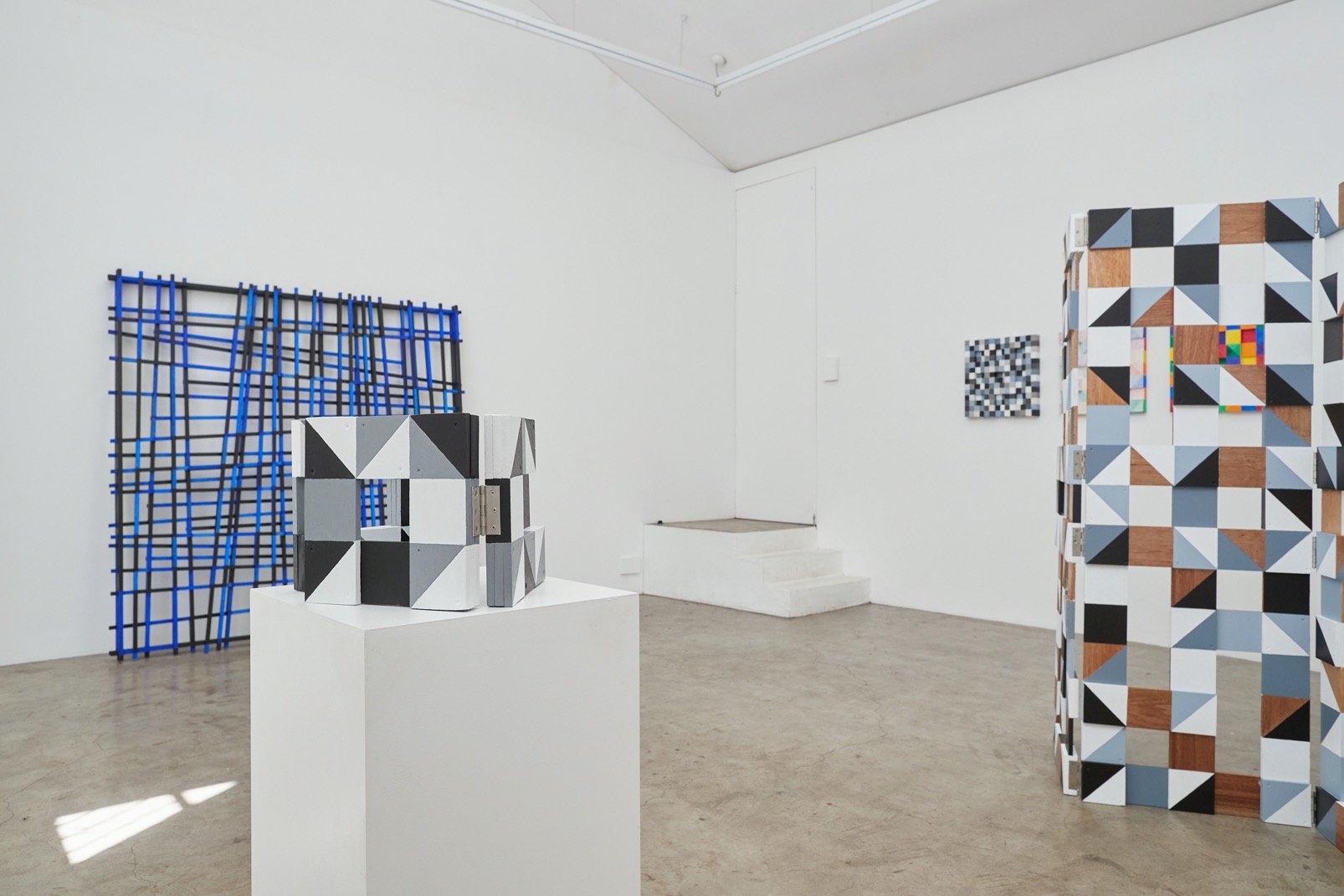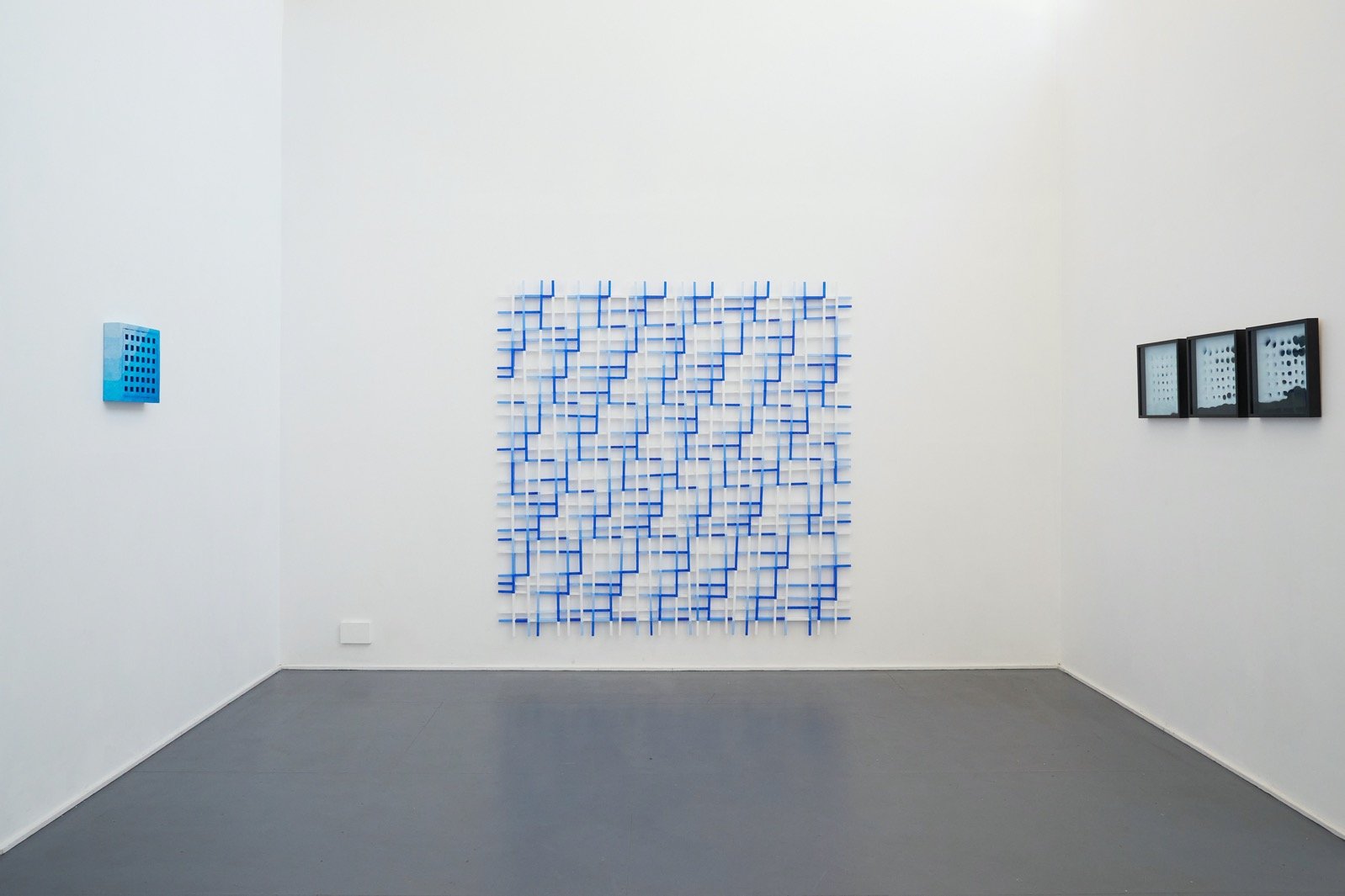
HILARIE MAIS: MELT + FOLD
@ Kronenberg Mais Wright, February 2023
The grid is just the beginning…
In 2018 Hilarie Mais travelled to a snow-topped mountain retreat in New Zealand with fellow artist Rosemary Laing. Immersed in the blue colour keys of snow and sky Mais turned to the aesthetic foundations of the grid as a means to explore the disorientation of the surrounding nature. Using a spike to pierce the snow on the cabin deck she formed a grid pattern in which voids created by the piercing action revealed the inner blue of the reflecting sky. Over the ensuing days Mais photographed the grid as the snow melted and morphed into irregular shapes as a form of unmaking. On her return to Sydney, Mais developed this simple repetitive action of forming a grid in snow by first making a wooden maquette representation, which together with the photographs became the basis for working with a glass artist to construct a series of fused glass works. Sandblasted into creation the MELT sculptures are both traces of the performative action of piercing the snow and echoes of the ensuing photographic rendition. The already disintegrating formal qualities of the grid are revisited in a further version of cast aluminium, a 3-dimensional interpretation—rather than a strict representation—of the original action and its grid form.
The corporeal resonance of the initial event in multiple media reveals an ongoing tension in Mais’ work that plays out across the spatial elements of repetition and time. Found in both nature and the made-world, the grid is the basis for geometrical transcendence, or as Rosalind Krauss once noted “the grid is a staircase to the Universal.”[1] Although Krauss was referencing Mondrian and Malevich, her observations on the spatial and temporal qualities of the grid as a visual structure resonate with Mais’ life-long investigation of the form. While Krauss often refers to the grid’s formal qualities of flatness, Mais uniquely takes this ubiquitous form into a multiplicity of interpretations and reinterpretations across various media and dimensions.
In encountering time as both linear and folded spatial elements in the world we come to understand the grid as a means by which we can measure time’s universal, but also impossible ephemeral presence. Folded time, for instance, can be thought of in terms of memory, a repetitive often involuntary process that brings moment of the past into the present like a long thread of knotted twine picking up traces of debris along the way. Mais considers the fold of time through material qualities of timber, paint, glass or metal in her ongoing investigation of the grid’s capacity to integrate and disintegrate spatial planes.
The concept of the FOLD and the act of folding appears here in various iterations, thought of by Mais in its more literal sense of to “fold” but also in the sense of reflection and mirroring. FOLD Still Standing 2022 invites the viewer to circumnavigate its folded forms that appear, at its most obvious as a folding screen, but also in more subtle ways as surface and depth disintegrate and fragment across painted and bare timber. Its solidity and transparency are imbued with unfolding rhythmic fragility. This sense of disorientation is often seen in the Grid works, in which specific systems of directional impetus, shape, rhythm, and colour both comply with and break Mais’ applied rules. Such systems, as used across minimalist, geometric, and conceptual art, such as those of Brice Marden and others, offer structures for working that are always already endlessly adaptable. The contradictory complex systems of duality and harmony can be seen in GRID VII /WEB 2023, and Willow 2019, that extend the periodic Grid series Mais commenced in the 1980s.
Both GRID VII/WEB and Willow, embody personal experiences, as in most of Mais’ structures. The first being a journey to Japan where Mais encountered Shou Sugi Ban made by the traditional Japanese method of Yakisugi to preserve wood through the process of charring. The barrier of the blackened surface protects the wood and acts as a life-preserving shield. Here the blackened structure is countered by blue interventions at startling angles that confuse space in their irregularity as they either stop abruptly or break over the edge of the work in ordered chaos. This unsettling rhythmic sensation can also be seen in Square Play 1, 2, 3 and 4 from 2021 and in Willow. Here the irregular structure suggests the fragility of porcelain, its blue tones reminding us of the chinoiserie willow pattern found throughout British homes since the late eighteenth century. Produced by Thomas Minton and others by adapting motifs of blue-and-white wares from China, the willow pattern supposedly narrates a constellatory tale of two separated lovers who meet once a year when the stars align. For many the pattern is a reminder of family dinners, lost generations and lovers. The layers of colour seen here and across Mais’ structures are themselves built up over time on a base of white primer that illuminates the works from beneath, much like porcelain.
Despite the perceived coolness or distance that can be experienced across minimalist artwork such as those from the 1960s—think here of the Specific Objects of Donald Judd, or works by Carl Andre, Anne Truitt, or indeed Barnett Newman’s paintings—such works at times respond to origins that lie beyond themselves. Newman famously painted a portrait of his father Abraham as an abstracted representation in varying tones of black. Similarly, throughout Mais’ oeuvre lies a biographical spine that permeates the works in a quiet, subtle way as it ebbs along at the edge of things. The Diary series embody the personal in the ways in which these works mark time throughout any given year as a reflection on life’s journey, with experiential traces embedded in the form, shape, and colour. They comprise paints that Mais and her husband Bill Wright accumulated over many years; paints that symbolise a relationship’s time, reflected through friends and places lived.
The chosen palette embodies a particular overarching mood, painted in rotating triangles across a surface that is punctuated by varying depths in shallow relief. The system here is strict until it is not. The language-based codes and systems of Mais’ sculptural evocations are revealed through colour that makes its presence felt at the work’s edge or underside, often emanating a reflected glow on the gallery wall. These often-brilliant colours, as seen in the Diary series, are at times muted by white, a purity of colour that in its very presence allows the contrasting colours to breathe. This sensation, seen in the Diary and Willow structures, is reminiscent of Mais’ Ghost series that explore loss and the transient qualities of life.
Throughout, Mais honours the voice and essence of the material, whether it be wood, glass, or metal. The works evolve gradually, over time—a month, a year, a life-time—each pulling a narrative thread from one to the other as a temporal gauge embodied in structural unity. Mais thinks of the grid as a beginning, as “a meditative point on which to overlay the emotional, the experiential and the narrative—indeed, the feminisation of minimalism.”[2] The ubiquity and power of the grid resonates throughout Mais’ oeuvre in these experiential terms that underpin moments of time as it imposes itself in a narrative that modulates the temporal, the chaotic, and the systematic. This ongoing sense of the grid unravelling, unmaking and making is suggestive of Nietzsche’s thoughts on memory as “loose sheets from the scroll of time,” an imperfect tense of “it was” that remains in ongoing oppositional presence.[3]
Donna West Brett, University of Sydney
February 2023
[1] Rosalind Krauss, Grids: Format and Image in 20th Century Art, 1978 (New York: Pace Gallery, 1980), UP.
[2] “Hilarie Mais in conversation with William Wright AM,” in Blair French and Manya Sellers (eds), Hilarie Mais (Sydney: Museum of Contemporary Art Australia, 2017), 36.
[3] Friedrich Nietzsche, “Unmodern Observations,” from Hilarie Mais, Visual Diary, 2023.




